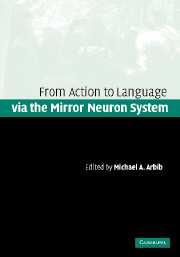Book contents
- Frontmatter
- Contents
- List of contributors
- Preface
- Part I Two perspectives
- Part II Brain, evolution, and comparative analysis
- Part III Dynamic systems in action and language
- 6 Dynamic systems: brain, body, and imitation
- 7 The role of vocal tract gestural action units in understanding the evolution of phonology
- 8 Lending a helping hand to hearing: another motor theory of speech perception
- Part IV From mirror system to syntax and Theory of Mind
- Part V Development of action and language
- Index
- References
6 - Dynamic systems: brain, body, and imitation
Published online by Cambridge University Press: 01 September 2009
- Frontmatter
- Contents
- List of contributors
- Preface
- Part I Two perspectives
- Part II Brain, evolution, and comparative analysis
- Part III Dynamic systems in action and language
- 6 Dynamic systems: brain, body, and imitation
- 7 The role of vocal tract gestural action units in understanding the evolution of phonology
- 8 Lending a helping hand to hearing: another motor theory of speech perception
- Part IV From mirror system to syntax and Theory of Mind
- Part V Development of action and language
- Index
- References
Summary
Introduction
The Mirror System Hypothesis (MSH) (see Arbib, Chapter 1, this volume) postulates that higher communication skills and language may be grounded in the basic skill of action recognition, enhanced by the ability of movement pantomime and imitation. This chapter will examine from a computational point of view how such recognition and imitation skills can be realized. Our goal is to take our formal knowledge of how to produce simple actions, also called movement primitives, and explore how a library of such movement primitives can be built and used to compose an increasingly large repertoire of complex actions. An important constraint in the development of this material comes from the need to account for movement imitation and movement recognition in one coherent framework, which naturally leads to an interplay between perception and action.
The existence of motor primitives (a.k.a. synergies, units of actions, basis behaviors, motor schemas, etc.) (Bernstein, 1967; Arbib, 1981; Viviani, 1986; Mataric, 1998; Miyamoto and Kawato, 1998; Schaal, 1999; Sternad and Schaal, 1999; Dautenhahn and Nehaniv, 2002) seems, so far, the only possibility for how one could conceive that biological and artificial motor systems are able to cope with the complexity of motor control and motor learning (Arbib, 1981; Schaal, 1999, 2002a, 2002b; Byrne 2003). This is because learning based on low-level motor commands, e.g., individual muscle activations, becomes computationally intractable for even moderately complex movement systems. Our computational approach to motor control with movement primitives is sketched as an abstract flowchart in Fig. 6.1 (Schaal, 1999).
- Type
- Chapter
- Information
- Action to Language via the Mirror Neuron System , pp. 177 - 214Publisher: Cambridge University PressPrint publication year: 2006
References
- 2
- Cited by



